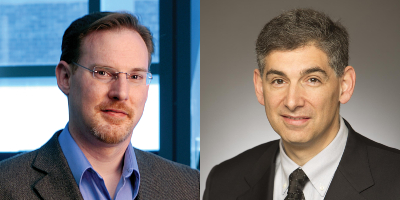For centuries, the principles of mechanics have been used to inform chemistry research. Now, Penn scientists and engineers are joining a multi-institution team of researchers to bring new knowledge to this field, known as mechanochemistry.
The team has been awarded a $1.8 million grant to establish the NSF Center for the Mechanical Control of Chemistry (CMCC), one of three new Phase I Centers for Chemical Innovation (CCI) funded through the National Science Foundation Division of Chemistry.

Robert Carpick, John Henry Towne Professor of Mechanical Engineering and Applied Mechanics and Professor of Materials Science Engineering, and Andrew M. Rappe, Blanchard Professor of Chemistry in Penn’s School of Arts & Sciences and Professor of Materials Science and Engineering, are leading Penn’s contingent of the CMCC. The Center will be led by James D. Batteas, the D. Wayne Goodman Professor of Chemistry at Texas A&M University.
According to Texas A&M, the CMCC “seeks to better understand how the precise application of mechanical forces can be used to alter chemical reaction rates and pathways at surfaces and interfaces.”
Carpick is an expert in the field of tribology, the study of friction and wear, and has long studied how the making and breaking of atomic bonds as two materials slide against each other can generate and instigate chemical reactions. Rappe’s expertise is in theoretical and physical chemistry, using analytic and computational models to predict how molecules and solids will behave when placed under mechanical stress.
In partnership with Eastman and Dow Chemical Companies, the Center will seek to create transformative mechanochemistry knowledge to enable new industrial scale processes for more energy-efficient, more selective, and safer chemical syntheses. Potential applications for this research include rapid prototyping of customized drugs or carrying out complex chemical syntheses on Mars using only locally sourced materials.
Batteas, Carpick, and Rappe are joined by co-investigators Jonathan R. Felts, Assistant Professor of Mechanical Engineering at Texas A&M; Adam Braunschweig, Associate Professor at CUNY and member of the Advanced Science Research Center at The Graduate Center, CUNY; Danna Freedman, Professor of Chemistry at Northwestern University; and Ashlie Martini, Professor of Mechanical Engineering at the University of California, Merced. Together, these researchers bring critical expertise in chemistry, physics, materials science and engineering mechanics to the project. Their research will shed light on a new perspective in chemical reactivity and bring forward new ideas in chemical synthesis technologies.
“Mechanochemistry is where chemistry and mechanics meet,” says Batteas. “By compressing or grinding molecules between surfaces, the forces applied can actually help drive reactions between the molecules. This can be used to carry out reactions at low temperatures and without solvents, reducing chemical waste. While this can be a very efficient way of doing chemistry, the outcomes are often unpredictable. In some cases, materials can even be formed that cannot be made through traditional methods, and this of course makes us ask: ‘Why and how do we take advantage of that?’ This is where the CMCC comes in — to bridge the knowledge gap that previously has impeded this from becoming an enabling technology for the chemistry community.”
Mechanochemistry has a special connection with Philadelphia, where M. Carey Lea, a Philadelphia-born lawyer and chemist, conducted breakthrough experiments in the 1800s, including using a mortar and pestle, to achieve chemical reactions mechanically instead of thermally, and showing that the mechanochemical reactions led to different and unique chemical products. Lea is sometimes referred to as “the father of mechanochemistry.”
“This Center brings together a rare combination of mechanical engineers and chemists to attack a long-standing problem: using forces to control chemical reactions,” says Carpick. “Our unique experimental and theoretical tools give us the ability to attack the problem that fascinated M. Carey Lea.”
“The opportunities in the area of mechanochemistry are vast,” says Rappe. “This emerging discipline can break or extend the rules of chemistry, leading to cost-efficient, atom-efficient, and green syntheses of molecules and materials. Establishing mechanical stress as a versatile tool in chemistry will enable breakthroughs in health, energy, water treatment and beyond; the CMCC is an expert interdisciplinary team that will lead mechanochemistry toward a bright future.”
